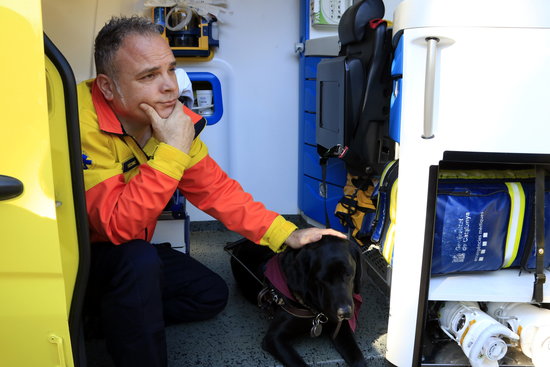Assistance dogs to be allowed in Catalan ambulances
Emergency service initiative to let dogs that help people with disabilities to go to hospital with owners is a first in Spain and Europe

An ambulance is one of those places you would least expect to see a dog, but assistance dogs, such as guide dogs trained to lead blind and visually impaired people, will now be allowed in ambulances to accompany their owners to hospital.
The initiative from the Catalan emergency service to install a mechanism to leash assistance dogs in ambulances is the first of its kind in Spain, and could even be the first time that such an idea has been adopted anywhere else in Europe.
Key to making the idea a reality was the collaboration of the Catalan wing of ONCE, Spain's foundation for the blind and people with serious visual impairment, whose experience with guide dogs was instrumental in developing the protocols for the initiative.
Five types of assistance dogs
There are five types of assistance dogs trained and registered to help people move around independently who may have different disabilities, from those with visual and hearing impairments to people with disorders such as autism, epilepsy or diabetes.
Assistance dogs that are correctly accredited and identified will be allowed in the ambulance with their owners as long as the state of the patient allows for it, with the animal secured to a special mechanism designed to latch on to the dog's harness.
If the situation demands it, the dog can also travel in the cabin with the driver thanks to a mechanism that secures the animal to a seat belt, with the dog sitting on the floor of the cabin for safety reasons, and on a paper mat for hygiene reasons.
Hospital will be notified ahead of time
On the journey, the ambulance will inform the emergency control center that it has an assistance dog on board, with the hospital taking it into safe keeping on arrival until it can be reunited with its owner. The dogs are not allowed in areas that must remain sterilized.
The head of the Catalan emergency services, Antoni Encinas, described the initiative as "a small major project," in that it is a cheap and easy solution to implement, but also one that answers the real needs of some patients with disabilities.
There are currently 189 registered guide dogs active in Catalonia: 156 in Barcelona, 18 in Tarragona, 14 in Girona and 1 in Lleida, with the breeds of dog most commonly used being Golden Retrievers, Flat-Coated Retrievers, and German Shepherds.